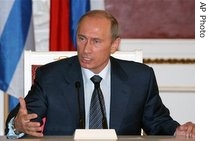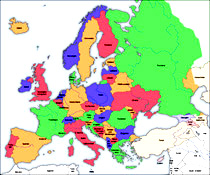-
(单词翻译:双击或拖选)
By André de Nesnera
Washington, D.C.
08 June 2007
A meeting bringing together the 30 signatories of the Conventional Forces in Europe Treaty begins in Vienna, Austria on Tuesday, June 12. The special session was called by Russia, which has announced that it will stop complying with the provisions of the pact1.
|
Treaty Provisions
The CFE pact set limits on the number of combat aircraft, attack helicopters, heavy artillery3, battle tanks and divisions that could be deployed4 between the Atlantic Ocean and Russia's Ural mountains.
Robert Hunter, former U.S. ambassador to NATO in the Clinton administration, says the treaty's main goal was to reduce the Warsaw Pact's overwhelming superiority in conventional weapons.
"The Conventional Forces in Europe Treaty is a legacy5 of the Cold War. It was originally negotiated in order to make the conventional force balance between NATO and the Warsaw Pact more transparent6 and more predictable, to reduce the chances of conflict -- not so much by design as by accident -- and also to enable countries to reduce the overall level of expenditure7 in what was becoming an outmoded confrontation8 which fortunately eventually came to an end,” says Hunter. “It limited certain kinds of equipment, particularly the expensive, heavy stuff like artillery and tanks, and also said that if forces would move from place 'X' to place 'Y', notice had to be given to the others."
Progress Stalled
But in July 1991, less than a year after the treaty was signed, the Warsaw Pact collapsed9. And in December of that year, the Soviet Union ceased to exist.
Wade10 Boese, from the Arms Control Association, a private research firm, says the CFE treaty was suddenly outdated11. "So in 1999, the state parties got together and said this treaty was still a worthwhile thing, 'Let's revise it to reflect current reality.' So essentially12, what they did was they shifted the treaty from one that would focus on balancing the two blocs14 to one that imposed national limits on each of the state parties. So this is what is referred to as the 'adapted treaty.' So there is a transition from bloc13 limits to national limits," says Boese.
The treaty cannot enter into force until all the current 30 states sign and ratify15 the revised agreement. Boese says to date, only four have done so -- Ukraine, Belarus, Kazakhstan and Russia.
"The NATO countries, the NATO members who are participants in the treaty, are withholding16 ratification17 until Russia fulfills18 some commitments that it made in 1999 to withdraw its military forces from Georgia and Moldova, which it has not done," says Boese. “Russia is making progress on the Georgian withdrawal19. It is supposed to close its last two remaining bases by the end of 2008. But there has been really little progress in Moldova since 2004. And at this time, approximately 1,300 Russian troops still remain in Transnistria. And that is a point of contention20."
But experts such as Robert Legvold from Columbia University in New York City say Moscow rejects NATO's view. "The Russians maintain that that is not a formal linkage21 and therefore the issue of the materiel and men in Transnistria and what remains22 in Georgia should not be a holdup for the ratification of the CFE," says Legvold.
U.S. - Russia Tensions
 |
| Russian President Vladimir Putin |
“I should point out that the moratorium was not immediate25 and has yet to take effect. The Russians are still implementing26 the CFE treaty today. What Putin said was that we would institute a moratorium if talks with NATO countries do not prove productive." says Wade Boese from the Arms Control Association.
Experts say President Putin's threat has heightened tensions between Russia and the United States that are already running high over a series of issues. These include Washington's withdrawal from the 1972 Anti Ballistic Missile Treaty, the plan to extend anti-missile defenses in Poland and the Czech Republic, and the use by NATO of bases in Bulgaria and Romania.
Former U.S. ambassador to NATO Robert Hunter says the Russians see these measures as further proof that NATO is moving into territories Moscow used to claim as its own.
"And I must say the Russians are not entirely27 without merit. Ten years ago, almost exactly, on May the 27th, Russia and NATO signed a thing called 'The NATO-Russia Founding Act.' And in that, NATO did have certain unilateral restrictions28 it placed on itself. It said, for example, that it would not engage in 'additional permanent stationing of substantial combat forces in central Europe,'" says Hunter. "Now the Russians would say that NATO-U.S. plans to put forces in Bulgaria and Romania violate that. Reasonable people can disagree. But in effect, this is Putin saying, 'I'm back, I'm standing29 tall; pay attention to me.'"
Tensions between Washington and Moscow overshadowed the just completed G-8 summit in Germany.
Experts do not expect any major breakthroughs in the near future. But they say it is a good sign that presidents Bush and Putin will meet one-on-one in early July in Kennebunkport, Maine -- at the estate of Mr. Bush's father -- to try to resolve key differences.
 收听单词发音
收听单词发音
1
pact

|
|
| n.合同,条约,公约,协定 | |
参考例句: |
|
|
|
2
Soviet

|
|
| adj.苏联的,苏维埃的;n.苏维埃 | |
参考例句: |
|
|
|
3
artillery

|
|
| n.(军)火炮,大炮;炮兵(部队) | |
参考例句: |
|
|
|
4
deployed

|
|
| (尤指军事行动)使展开( deploy的过去式和过去分词 ); 施展; 部署; 有效地利用 | |
参考例句: |
|
|
|
5
legacy

|
|
| n.遗产,遗赠;先人(或过去)留下的东西 | |
参考例句: |
|
|
|
6
transparent

|
|
| adj.明显的,无疑的;透明的 | |
参考例句: |
|
|
|
7
expenditure

|
|
| n.(时间、劳力、金钱等)支出;使用,消耗 | |
参考例句: |
|
|
|
8
confrontation

|
|
| n.对抗,对峙,冲突 | |
参考例句: |
|
|
|
9
collapsed

|
|
| adj.倒塌的 | |
参考例句: |
|
|
|
10
wade

|
|
| v.跋涉,涉水;n.跋涉 | |
参考例句: |
|
|
|
11
outdated

|
|
| adj.旧式的,落伍的,过时的;v.使过时 | |
参考例句: |
|
|
|
12
essentially

|
|
| adv.本质上,实质上,基本上 | |
参考例句: |
|
|
|
13
bloc

|
|
| n.集团;联盟 | |
参考例句: |
|
|
|
14
blocs

|
|
| n.集团,联盟( bloc的名词复数 ) | |
参考例句: |
|
|
|
15
ratify

|
|
| v.批准,认可,追认 | |
参考例句: |
|
|
|
16
withholding

|
|
| 扣缴税款 | |
参考例句: |
|
|
|
17
ratification

|
|
| n.批准,认可 | |
参考例句: |
|
|
|
18
fulfills

|
|
| v.履行(诺言等)( fulfill的第三人称单数 );执行(命令等);达到(目的);使结束 | |
参考例句: |
|
|
|
19
withdrawal

|
|
| n.取回,提款;撤退,撤军;收回,撤销 | |
参考例句: |
|
|
|
20
contention

|
|
| n.争论,争辩,论战;论点,主张 | |
参考例句: |
|
|
|
21
linkage

|
|
| n.连接;环节 | |
参考例句: |
|
|
|
22
remains

|
|
| n.剩余物,残留物;遗体,遗迹 | |
参考例句: |
|
|
|
23
moratorium

|
|
| n.(行动、活动的)暂停(期),延期偿付 | |
参考例句: |
|
|
|
24
compliance

|
|
| n.顺从;服从;附和;屈从 | |
参考例句: |
|
|
|
25
immediate

|
|
| adj.立即的;直接的,最接近的;紧靠的 | |
参考例句: |
|
|
|
26
implementing

|
|
| v.实现( implement的现在分词 );执行;贯彻;使生效 | |
参考例句: |
|
|
|
27
entirely

|
|
| ad.全部地,完整地;完全地,彻底地 | |
参考例句: |
|
|
|
28
restrictions

|
|
| 约束( restriction的名词复数 ); 管制; 制约因素; 带限制性的条件(或规则) | |
参考例句: |
|
|
|
29
standing

|
|
| n.持续,地位;adj.永久的,不动的,直立的,不流动的 | |
参考例句: |
|
|
|
















